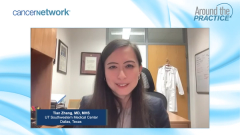
Patient Scenario 2: A 65-Year-Old Man With Metastatic Hormone-Sensitive Prostate Cancer
Centering focus on a second clinical scenario of metastatic hormone-sensitive prostate cancer, key opinion leaders identify treatment options based on variations in presentation.
Episodes in this series

Transcript:
Alan H. Bryce, MD: Case 2 is going to be a 65-year-old gentleman who had a prostatectomy 4 years earlier, Gleason grade group 4, T3b N0, and had an undetectable PSA [prostate-specific antigen] thereafter. In this case, germline testing shows no pathogenic variants. The somatic testing is different. Now we have a pathogenic SPOP variation, a TMPRSS2-ERG fusion protein, TMB [tumor mutational burden] 2.1 m/MB, and the tumor is MSI [microsatellite instability]-stable. Dr Petrylak, how is this patient different from the first case with regard to your algorithm for first-line therapy?
Daniel P. Petrylak, MD: He’s still a young patient, so we still are concerned about him, but you’ve shown he has no germline variance. But here, this is somebody who is not de novo, he’s been diagnosed with localized disease first and then he would go on to metastatic disease. That’s somebody who may be a bit less aggressive, and certainly we would want to find out where his disease sites are, but that I think is one of the factors we consider in what type of systemic therapy he will receive.
Alan H. Bryce, MD: I’m sorry, we should have said, the same metastatic burden as the last patient. It’s a multifocal bone disease, so high volume, no visceral metastasis, but metachronous not de novo. A bit older, metachronous, not de novo. This is kind of our intermediate population, not the highest risk, not the lowest. High in that it’s high volume, lower risk in that it’s metachronous. Where does this patient land, back to Dr Lowentritt, in terms of your triplet conversation, your algorithm compared to the last patient?
Benjamin H. Lowentritt, MD, FACS: As much as there is the difference between the de novo and the recurrent or metachronous patient, we do know there’s a benefit, or there was a demonstrated benefit in the trials, it appears to be in some of the analyses, in both groups. So I wouldn’t only offer triplet therapy to the de novo patient, and because this is a symptomatic high-volume patient with hopefully good functional status, I would still have that conversation with them for sure. Four years after a prostatectomy isn’t that long. He had T3b GG4 [Gleason grade group 4] at diagnosis. It’s interesting that his [PSA] nadir was at an undetectable level. All these things, generally, it takes a little longer to get to the point where you have symptomatic metastatic disease, so I do worry that he has a more aggressive disease even though he’s recurrent. I would still offer it, but this is one of those patients where you want to make sure he gets on at least 2 of the 3, and maybe go for triplet therapy if he’s amenable.
Alan H. Bryce, MD: We create these definitions, but of course it’s all a continuum, and there’s delayed presentation, and then there’s delayed presentation. Four years or 14 is a different story, isn’t it? Dr Zhang, what about the genetics for this patient? How would you describe to him our findings here?
Tian Zhang, MD, MHS: I would say that for SPOP and TMPRSS2-ERG, these are common alterations that we see in prostate cancer. There are some series of patients where SPOP mutations tend to have more susceptibility to treatments directed in the androgen receptor axis, so they seem to be more AR [androgen receptor] susceptible. That’s a good thing to have and a good prognostic marker. Otherwise, nothing’s jumping out at me as saying we would think about PARP inhibitors or other things, except in blanket approval settings in later-line treatments.
Alan H. Bryce, MD Yes, fair.
Benjamin H. Lowentritt, MD, FACS: Just a question to the group so I can learn. If this patient presented, and they had the same findings we saw before is one thing, but if they didn’t have that big lesion on the hip and maybe just some scattered smaller lesions in the bones, what would you test first? Would you go back 4 years to the prostatectomy specimen? Would you do a biopsy of a vertebral metastasis if it’s small? How would you proceed with finding tissue or finding a way? Would you do a liquid test for circulating DNA? How would you approach that?
Alan H. Bryce, MD: How about Dr Petrylak, what would you do?
Daniel P. Petrylak, MD: If it’s a short interval, obviously I’m probably not going to repeat it. The real question is, there are not a lot of data telling us how these may evolve clonally over time. I’ve seen situations where patients have developed somatic BRCA mutations, which would clearly have an impact on their treatment. It did in this particular patient’s case. If you are more than a couple of years out, I would want to repeat that biopsy, whether it be liquid biopsy or something that could easily be accessed with a needle. It’s something that intuitively makes sense, but I don’t think there are a lot of data telling us what to do.
Alan H. Bryce, MD: I agree, freshest tissue is best. I tend to say if I’m going back to old tissue, I use a cutoff in a case like this of 5 years. Older than that, the quality of the DNA really falls off, and I am less confident about the readout. I think things get missed. Then liquid is always available, cell-free DNA is always available. The tumor has definitely evolved, so I like using cell-free DNA if there’s nothing we can biopsy, I would say.
Transcript edited for clarity.
Newsletter
Stay up to date on recent advances in the multidisciplinary approach to cancer.























































































